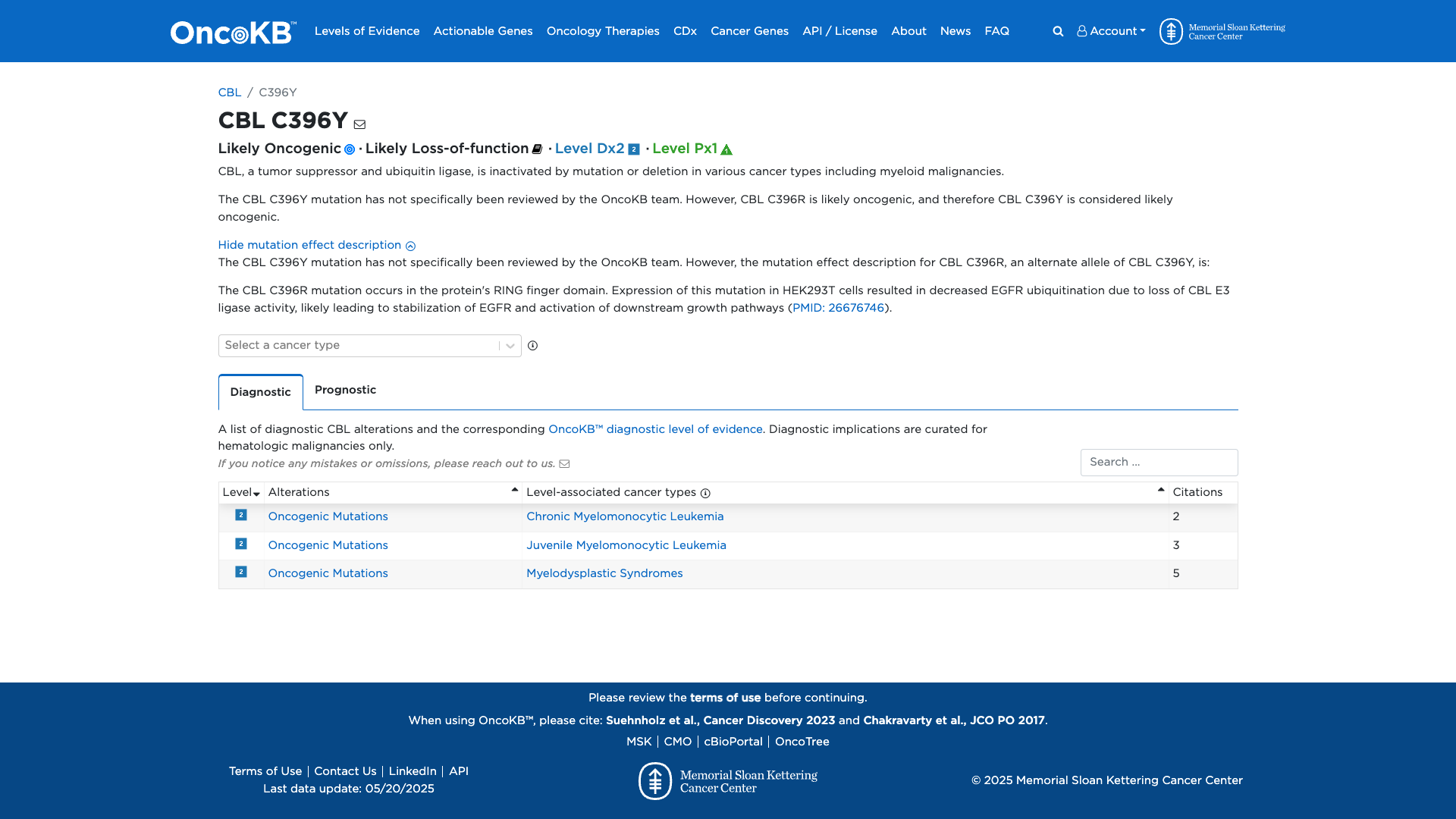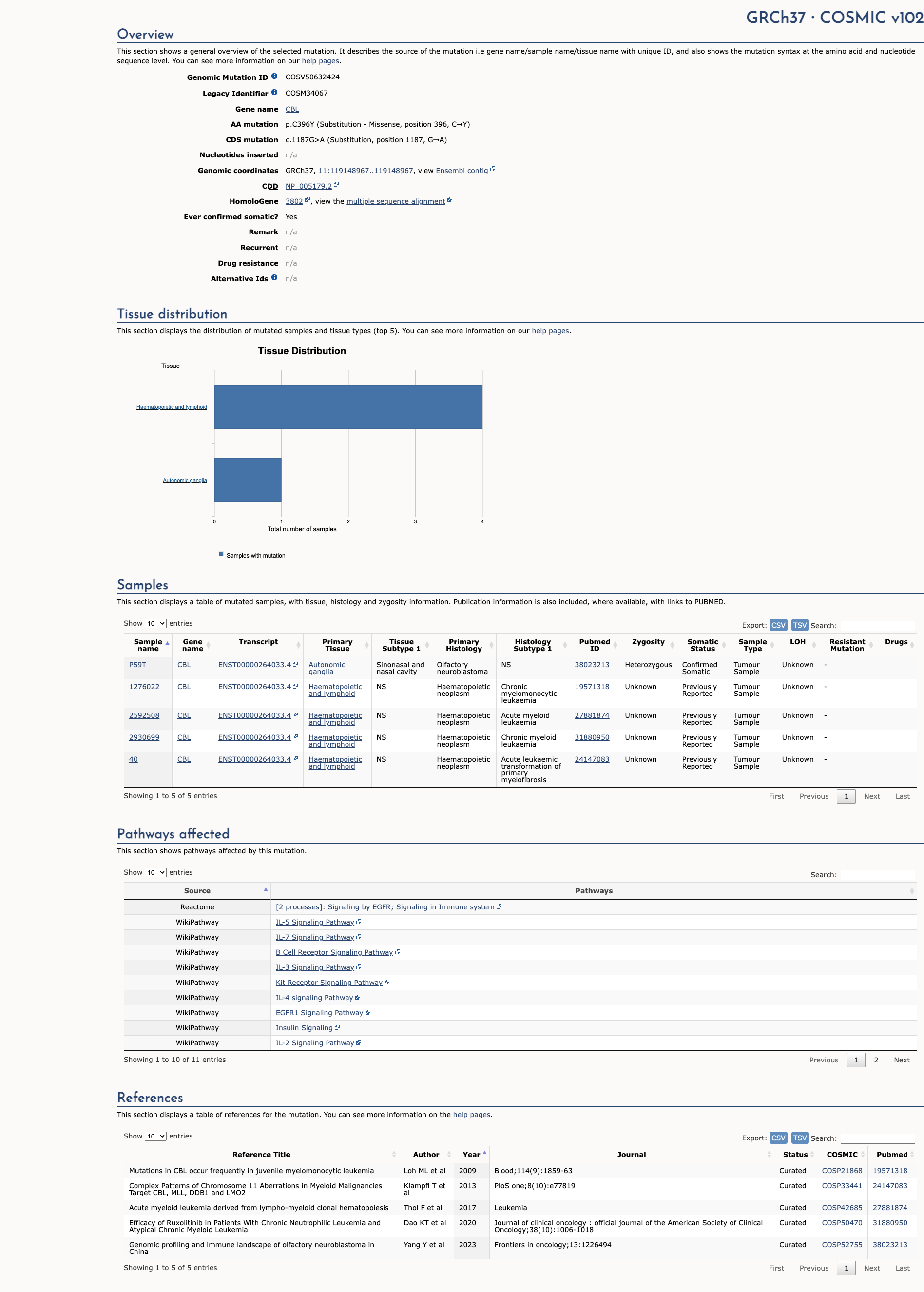CBL c.1187G>A, p.Cys396Tyr
NM_005188.3:c.1187G>A
COSMIC ID: COSM34067
Variant of Uncertain Significance (VUS)
The CBL c.1187G>A (C396Y) variant remains classified as a Variant of Uncertain Significance. It meets PM2 and PM5 at Moderate strength and PP3 at Supporting strength, but lacks sufficient additional evidence to reach Likely Pathogenic or Likely Benign.
ACMG/AMP Criteria Applied
PM2
PM5
PP3
Genetic Information
Gene & Transcript Details
Gene
CBL
Transcript
NM_005188.4
MANE Select
Total Exons
16
Strand
Forward (+)
Reference Sequence
NC_000011.9
Alternative Transcripts
| ID | Status | Details |
|---|---|---|
| NM_005188.3 | RefSeq Select | 16 exons | Forward |
| NM_005188.2 | Alternative | 16 exons | Forward |
Variant Details
HGVS Notation
NM_005188.3:c.1187G>A
Protein Change
C396Y
Location
Exon 8
(Exon 8 of 16)
5'Exon Structure (16 total)3'
Functional Consequence
Loss of Function
Related Variants
ClinVar reports other pathogenic variants at position 396: C396R
Alternate Identifiers
COSM34067
Variant interpretation based on transcript NM_005188.4
Genome Browser
Loading genome browser...
HGVS InputNM_005188:c.1187G>A
Active Tracks
ConservationRefSeqClinVargnomAD
Navigation tips: Use mouse to drag and zoom. Click on features for details.
Clinical Data
Population Frequency
Global Frequency
0.0 in 100,000
Extremely Rare
Global: 0.0%
0%
0.05%
0.1%
1%
5%
10%+
ACMG Criteria Applied
PM2
This variant is not present in gnomAD (PM2 criteria applies).
Classification
Uncertain Significance (VUS)
Based on 1 submitter review in ClinVar
Submitter Breakdown
1 VUS
Pathogenic
Likely Path.
VUS
Likely Benign
Benign
Publications (0)
No publication details.
Clinical Statement
This variant has been reported in ClinVar as Uncertain significance (1 clinical laboratories).
Functional Impact
Functional Domain
Hotspot Status
Not a hotspot
Domain Summary
This variant is not located in a mutational hotspot or critical domain (0 mutations).
Related Variants in This Domain
ClinVar reports other pathogenic variants at position 396: C396R
PM5 criterion applied.
Functional Summary
The CBL C396Y variant has not been directly functionally characterized. However, it is located in the RING finger domain of the CBL protein, where similar mutations have been shown to impair E3 ligase activity, leading to decreased ubiquitination and potential downstream effects. Computational modeling predicts that C396Y may disrupt CBL stability, but biochemical evidence confirming its impact on protein function is lacking.
Database Previews
OncoKB

JAX-CKB

Click on previews to view full database entries. External databases may require institutional access.
Computational Analysis
Pathogenicity Predictions
REVEL Score
0.949
0.949
Likely Benign0.0
Uncertain (Low)0.2
Uncertain (Med)0.5
Likely Pathogenic0.75
REVEL scores ≥ 0.75 are strong evidence (PP3)
Predictor Consensus
Mixed/VUS
PP3 Applied
Yes
Additional Predictors
Pathogenic:
polyphen_prediction: probably_damagingmutationtaster: Dmetasvm: Dmetalr: Dprimateai: D
Benign:
CADD: 6.01
Neutral: Show all
VCEP Guidelines
Applied ACMG/AMP Criteria (VCEP Specific)
PVS1
PVS1 (Not Applied) Strength Modified
According to standard ACMG guidelines, the rule for PVS1 is: "Null variant in a gene where loss of function (LoF) is a known mechanism of disease (e.g., nonsense, frameshift, canonical ±1 or 2 splice sites, initiation codon, single or multi-exon deletion in a LoF gene)". The evidence for this variant shows a missense change (C396Y), not a null variant. Therefore, this criterion is not applied.
PS1
PS1 (Not Applied) Strength Modified
According to standard ACMG guidelines, the rule for PS1 is: "Same amino acid change as a previously established pathogenic variant regardless of nucleotide change". The evidence for this variant shows no prior pathogenic variant resulting in the same C396Y amino acid change. Therefore, this criterion is not applied.
PS2
PS2 (Not Applied) Strength Modified
According to standard ACMG guidelines, the rule for PS2 is: "De novo (both maternity and paternity confirmed) in a patient with the disease and no family history". There are no data on de novo occurrence for this variant. Therefore, this criterion is not applied.
PS3
PS3 (Not Applied) Strength Modified
According to standard ACMG guidelines, the rule for PS3 is: "Well-established functional studies show a damaging effect on the gene or gene product". The evidence for this variant shows no direct functional studies confirming a damaging effect. Therefore, this criterion is not applied.
PS4
PS4 (Not Applied) Strength Modified
According to standard ACMG guidelines, the rule for PS4 is: "Prevalence in affected individuals is significantly increased compared with controls". No case-control or prevalence data are available for this variant. Therefore, this criterion is not applied.
PM1
PM1 (Not Applied) Strength Modified
According to standard ACMG guidelines, the rule for PM1 is: "Located in a mutational hot spot and/or a well-established functional domain without benign variation". While C396Y lies in the RING finger domain, there is insufficient gene-specific evidence demonstrating that this domain qualifies as a mutational hotspot devoid of benign variation. Therefore, this criterion is not applied.
PM2
PM2 (Moderate)
According to standard ACMG guidelines, the rule for PM2 is: "Absent from controls (or at extremely low frequency if recessive) in Exome Sequencing Project, 1000 Genomes Project, or Exome Aggregation Consortium". The evidence for this variant shows a MAF of 0% in gnomAD and other population databases. Therefore, this criterion is applied at Moderate strength because the variant is absent from population controls.
PM3
PM3 (Not Applied) Strength Modified
According to standard ACMG guidelines, the rule for PM3 is: "Detected in trans with a pathogenic variant for a recessive disorder". This variant is not known to be in trans with any pathogenic CBL variant, nor is CBL associated with a recessive mechanism requiring PM3. Therefore, this criterion is not applied.
PM4
PM4 (Not Applied) Strength Modified
According to standard ACMG guidelines, the rule for PM4 is: "Protein length changes due to in-frame deletions/insertions or stop-loss variants". The evidence for this variant shows a missense change with no alteration of protein length. Therefore, this criterion is not applied.
PM5
PM5 (Moderate)
According to standard ACMG guidelines, the rule for PM5 is: "Novel missense change at an amino acid residue where a different missense change determined to be pathogenic has been seen before". The evidence for this variant shows that C396 has been altered by other missense changes classified as pathogenic. Therefore, this criterion is applied at Moderate strength because it is a novel missense change at a known pathogenic residue.
PM6
PM6 (Not Applied) Strength Modified
According to standard ACMG guidelines, the rule for PM6 is: "Assumed de novo, but without confirmation of paternity and maternity". There is no evidence of de novo occurrence for this variant. Therefore, this criterion is not applied.
PP1
PP1 (Not Applied) Strength Modified
According to standard ACMG guidelines, the rule for PP1 is: "Co-segregation with disease in multiple affected family members". No segregation data are available for this variant. Therefore, this criterion is not applied.
PP2
PP2 (Not Applied) Strength Modified
According to standard ACMG guidelines, the rule for PP2 is: "Missense variant in a gene with a low rate of benign missense variation and where missense variants are a common mechanism of disease". There is insufficient data on the benign missense variation rate in CBL to confidently apply this criterion. Therefore, this criterion is not applied.
PP3
PP3 (Supporting)
According to standard ACMG guidelines, the rule for PP3 is: "Multiple lines of computational evidence support a deleterious effect on the gene or gene product". The evidence for this variant shows a REVEL score of 0.95, along with damaging predictions from PolyPhen, MutationTaster, MetaSVM, MetaLR, and PrimateAI. Therefore, this criterion is applied at Supporting strength because multiple in silico tools predict a deleterious effect.
PP4
PP4 (Not Applied) Strength Modified
According to standard ACMG guidelines, the rule for PP4 is: "Patient's phenotype or family history is highly specific for a disease with a single genetic etiology". No phenotype or clinical information is provided. Therefore, this criterion is not applied.
PP5
PP5 (Not Applied) Strength Modified
According to standard ACMG guidelines, the rule for PP5 is: "Reputable source reports variant as pathogenic, but without accessible evidence". The only report in ClinVar classifies this variant as Uncertain Significance. Therefore, this criterion is not applied.
BA1
BA1 (Not Applied) Strength Modified
According to standard ACMG guidelines, the rule for BA1 is: "Allele frequency is >5% in population databases". The evidence for this variant shows a frequency of 0% in gnomAD. Therefore, this criterion is not applied.
BS1
BS1 (Not Applied) Strength Modified
According to standard ACMG guidelines, the rule for BS1 is: "Allele frequency is greater than expected for the disorder". The evidence shows a frequency of 0% in population databases. Therefore, this criterion is not applied.
BS2
BS2 (Not Applied) Strength Modified
According to standard ACMG guidelines, the rule for BS2 is: "Observed in a healthy adult individual for a dominant disorder with full penetrance expected at an early age". There are no reports of this variant in healthy individuals. Therefore, this criterion is not applied.
BS3
BS3 (Not Applied) Strength Modified
According to standard ACMG guidelines, the rule for BS3 is: "Well-established functional studies show no damaging effect on protein function or splicing". No functional studies demonstrating lack of effect are available. Therefore, this criterion is not applied.
BS4
BS4 (Not Applied) Strength Modified
According to standard ACMG guidelines, the rule for BS4 is: "Lack of segregation in affected family members". No segregation analysis data are available. Therefore, this criterion is not applied.
BP1
BP1 (Not Applied) Strength Modified
According to standard ACMG guidelines, the rule for BP1 is: "Missense variant in a gene where only loss-of-function causes disease". CBL has disease mechanisms beyond simple loss-of-function, and there is no evidence to support this criterion. Therefore, this criterion is not applied.
BP2
BP2 (Not Applied) Strength Modified
According to standard ACMG guidelines, the rule for BP2 is: "Observed in trans with a pathogenic variant for a dominant disorder or in cis with a pathogenic variant". No such observations are reported. Therefore, this criterion is not applied.
BP3
BP3 (Not Applied) Strength Modified
According to standard ACMG guidelines, the rule for BP3 is: "In-frame deletions/insertions in a repetitive region without a known function". This is a missense variant, not an in-frame indel. Therefore, this criterion is not applied.
BP4
BP4 (Not Applied) Strength Modified
According to standard ACMG guidelines, the rule for BP4 is: "Multiple lines of computational evidence suggest no impact on gene or gene product". In silico tools predict a deleterious effect. Therefore, this criterion is not applied.
BP5
BP5 (Not Applied) Strength Modified
According to standard ACMG guidelines, the rule for BP5 is: "Variant found in a case with an alternate molecular basis for disease". No such cases are reported. Therefore, this criterion is not applied.
BP6
BP6 (Not Applied) Strength Modified
According to standard ACMG guidelines, the rule for BP6 is: "Reputable source reports variant as benign, but without accessible evidence". No benign assertions are available. Therefore, this criterion is not applied.
BP7
BP7 (Not Applied) Strength Modified
According to standard ACMG guidelines, the rule for BP7 is: "Synonymous variant with no predicted impact on splicing". This is a missense variant. Therefore, this criterion is not applied.

